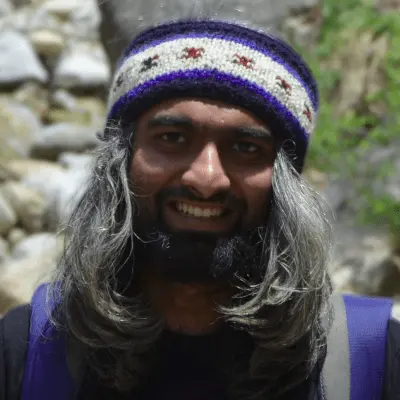My research
The (over-)simplified summary of various projects that I have undertaken. Feel free to contact me if you wish to discuss any of these projects!
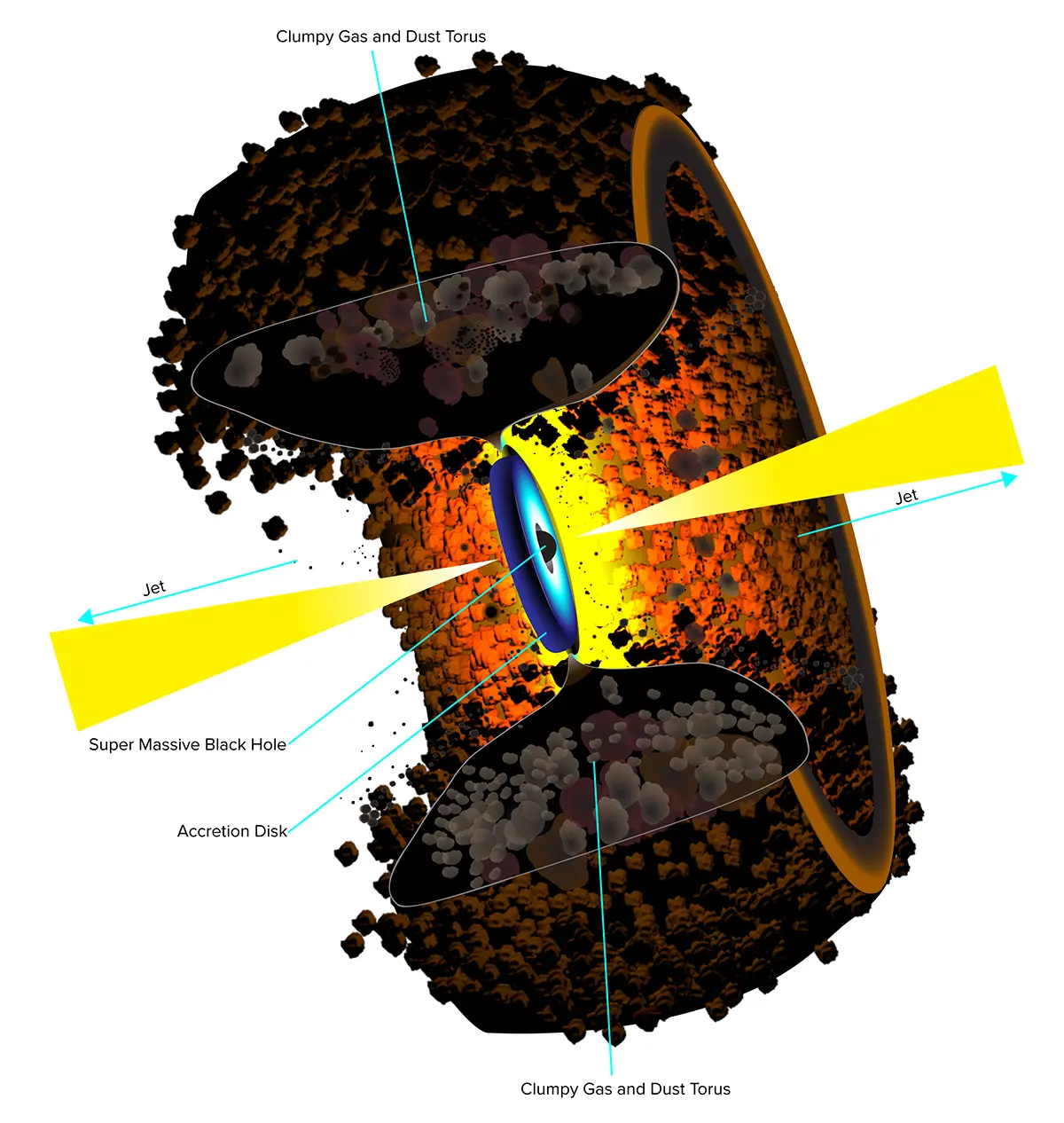
Unified model of AGN
Credit: B. Saxton NRAO/AUI/NSF
Obscuration geometry around AGN
Active Galactic Nucleus (AGN) is a highly luminous compact region at the center of a galaxy. Despite the first AGNs being discovered over 100 years ago, our understanding, till today, of AGN activity and the processes regulating it remains severely incomplete. Detailed studies of the individual sources are extremely useful, providing a magnifying glass to study the circum-nuclear environment around the central supermassive black hole that drives the emission from the AGNs. This project is multi-mission broadband study of x-ray spectrum of one such heavily obscured AGN using robust global sampling algorithms in Bayesian X-ray Analysis (BXA) package. Dr. Aru Beri and Dr. Peter Boorman are supervising this project.
- Key conecepts:Reprocessing of intrinsic x-ray emission by obscuring material, Obscuration geometry, Bayesian inference, Nested sampling algorithms.
- Computational tools:BXA package, PyXspec, mission specific FTOOLS in HEASoft

Voronoi tessellation by radial growth in 2D
Credit: Jahobr, CC0
Constrainting galaxy evolution and cosmology using novel clustering statistics
Voronoi tessellations based Voronoi Volume Function (VVF) is a novel unexplored probe for cosmology and galaxy evolution. We (Dr. Shadab Alam, Dr. Aseem Paranjape, and I) use VVF as a clustering statistic and simulated galaxy redshift catalogues to study the power of VVF in constraining parameters governing galaxy formation in dark matter halos as well as the cosmological parameters simultaneously.
- Key conecepts:Fisher formalism, interplay between science of galaxy evolution and primordial cosmology.
- Computational tools:scikit-learn and gaussian processes, ChainConsumer
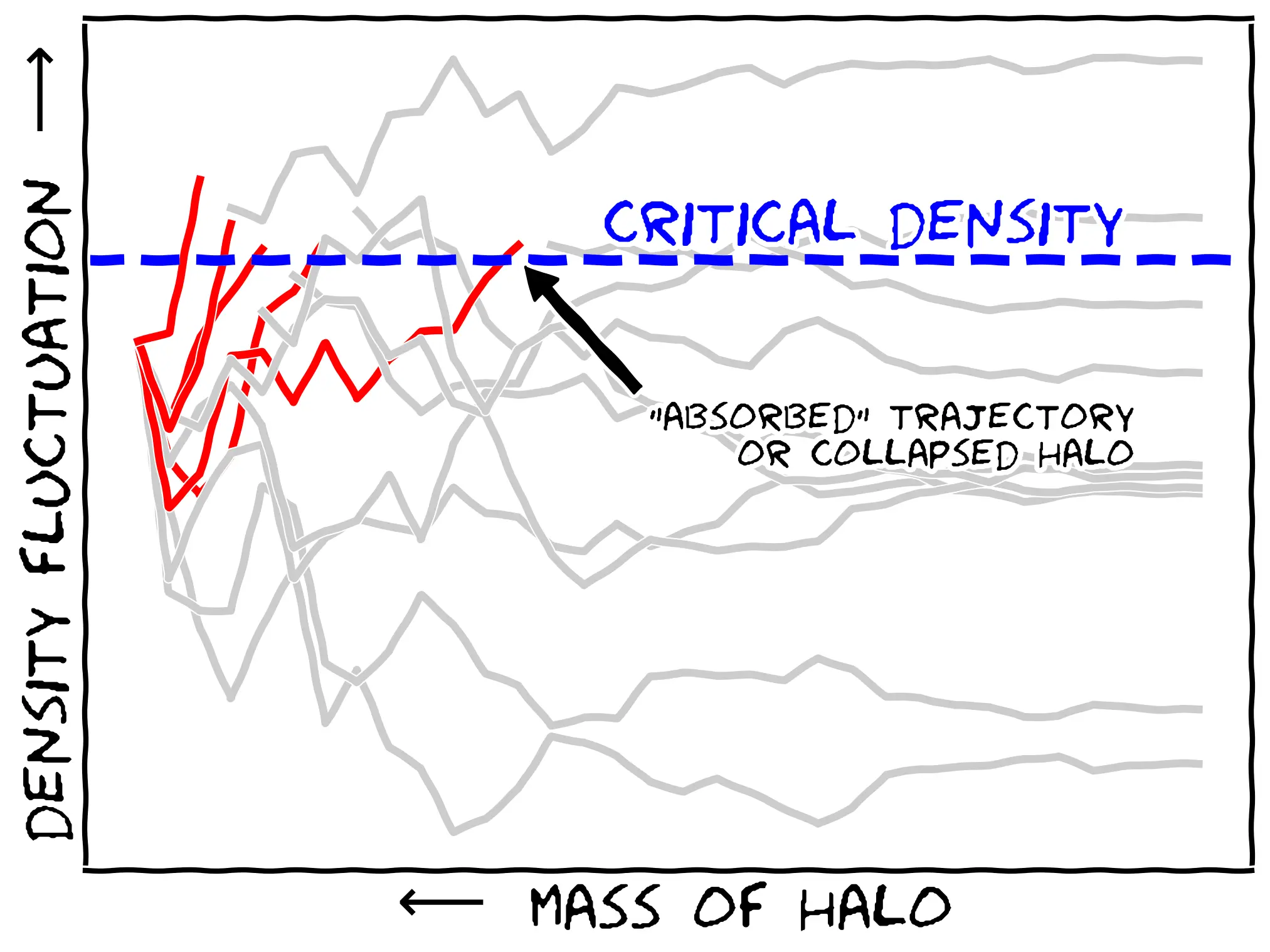
Cartoon of excursion set approach for collapse of dark matter halos
Credit: Devang Liya and XKCD in matplotlib
Mass Function of Collapsed Halos and the Excursion Set
Observed mass distribution of the dark matter halos in the universe — known as halo mass function — shows significant departures from theoretical predictions. Modelling the halo collapse as a stochastic problem could help us explain the observed departures. This approach is called excursion set approach. In my master's thesis, I reviewed the properties of the dark matter halos, methods to study them, and methods to predict the form of the halo mass function. I also developed a set of programs for simulating the excursion set formalism with arbitrary absorbing barrier and an arbitrary matter power spectrum. Prof. Jasjeet Singh Bagla was my supervisors for this project.
- Key conecepts:Halo model, Excursion set theory, Stochastic modelling
- Computational tools:Python

Drawing of SWAN setup at Gauribidanur Radio Observatory
Credit: SWAN
Looking at the radio sky
The sky looks drastically different in different wavelenths of light. Each wavelength requires specialized telescopes and training in using those telescopes. Sky Watch Array Network (SWAN) is a MWA type radio telescope. We used this setup to observe the Sun, developed a pipeline to process the raw data generated from the telescope, performed interferometary and finally produced an image of the Sun at 195 MHz. Snippets of code used in the pipeline can be found in this repository. Feel free to contact me if you need additional resources or have suggestions on improving the pipeline.
- Key conecepts:Data processing from radio telescope, Aperture synthesis
- Computational tools:Python, numpy, scipy, matplotlib, CASA
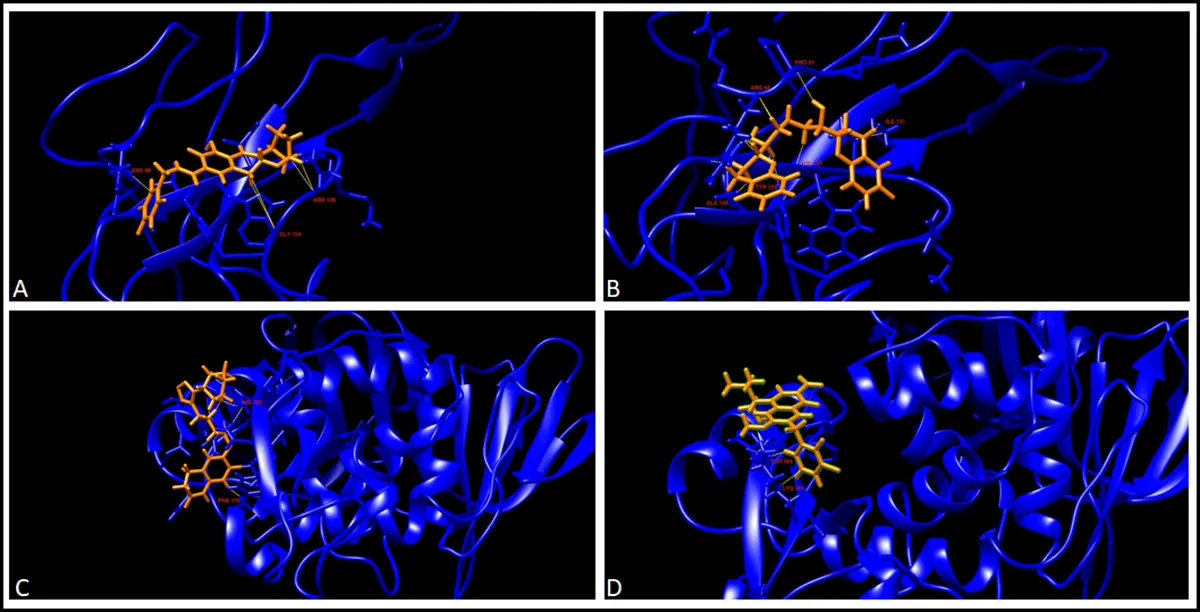
Drug-protein interaction after docking
Credit: Anand NM, Liya DH+ (2021)
Identifying drug targets in SARS-CoV-2
COVID-19 pandemic that made the Zoom an integral part of our lives, was caused by a virus named SARS-CoV-2. We developed CRAM — a tiny piece of code to identify the non-mutating stable sites in the SARS-CoV-2 genome. We then used these sites for drug targeting and studied the interaction between the selected drugs and the protein produced by the stable sites using molecular dynamics simulations. This work was done in collabortation with Ashwin Kumar Jainarayanan of University of Oxford, and Dr. Arpit Kumar Pradhan of Ludwig Maximilian University of Munich. The results are peer reviewed and published in PLOS One.
- Key conecepts:Mutation analysis, Molecular dynamics simulations.
- Computational tools:Use of cluster for parallel computing, Desmond
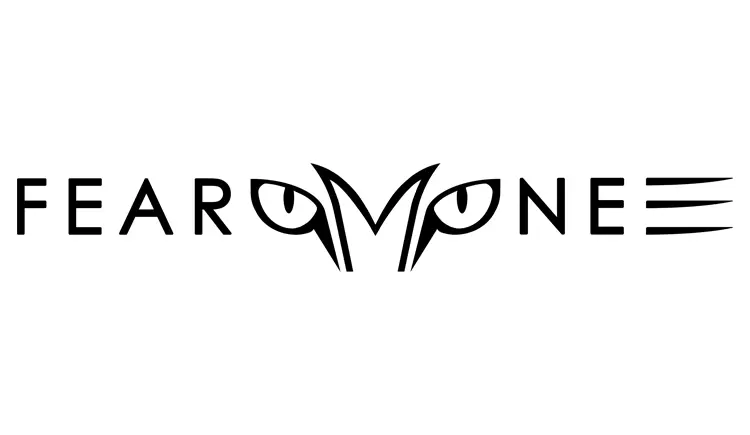
Credit: Sveekruth Pai, IISER-Mohali iGEM'18
FearoMone
Nearly 40% of India's foodgrain production is lost during the post-harvest phase. Rats and mice are one of the major causes of this loss. Inspired by the natural prey-predator relationship between rats and cats, we developed a bio-synthetic deterrent by using genetically engineered yeast to produce cat pheromones. We also developed variety of hardwares and softwares to safely deploy the product. We presented this work at the Giant Jamboree held in Boston, USA and were awarded a bronze medal along with a nomination for the best food and nutrition project. Visit the project website to learn more!
- Key conecepts:Synthetic biology, Diffusion, 3D printing.
- Computational tools:Python, MATLAB
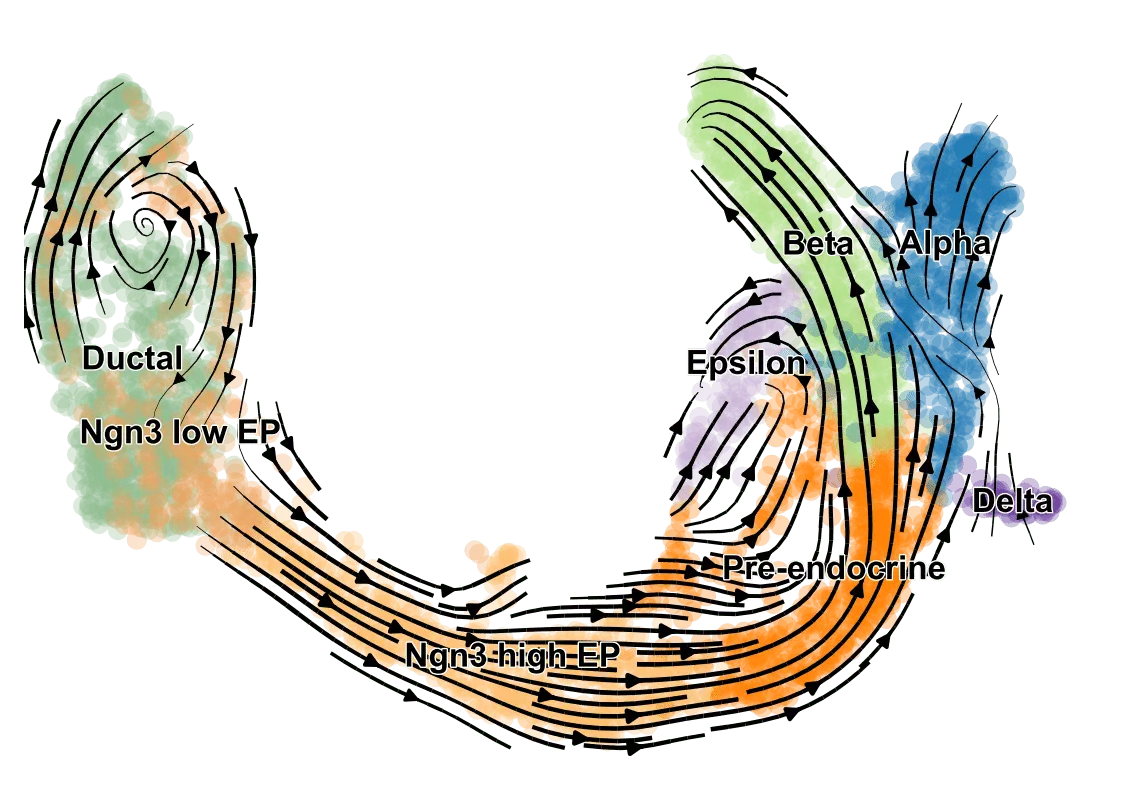
Pancreatic endocrinogenesis
Credit: Bastidas-Ponce+ (2019)
Other projects
Publications and Outreach
Published articles
Submitted
In preparation
Outreach
I strongly believe that everyone must get the opportunity to experience the excitement of doing science irrespective of their background. Therefore, I have always been actively involved in science communication and outreach activities. Following are some highlights from those activities.
Curriculum Vitae
Education
PhD in Astrophysics
2022 - 2026 (expected)
Newcastle University, Newcastle upon Tyne, UK
My research is related to the cosmic evolution of near-nuclear dust in Active Galactic Nuclei (AGN), which are growing supermassive black holes (SMBHs), using JWST and other multi-wavelength surveys. I am also training in data sciences as part of the NUdata CDT program.
Integrated Masters in Physics
2017 - 2022
Indian Institute of Science Education and Research, Mohali, India
Physics major with a minor in astronomy and astrophysics from the Department of Physical Sciences at IISER-Mohali, India.
Bachelor of Computer Engineering
2016 - 2017
Vivekanand Education Society's Institute Of Technology, Mumbai, India
Completed two semesters of coursework in the Department of Computer Engineering at VESIT. Dropped out to pursue research in natural sciences.
Coursework
- Physics: Classical mechanics, Electrodynamics, Advanced quantum mechanics, Thermodynamics and statistical mechanics, Solid state physics, Nuclear and particle physics.
- Astronomy: Astronomy & Astrophysics, Astrophysical processes and stars, Galaxies and Cosmology, High energy astrophysics, Physics of fluids
- Mathematics: Group theory & linear algebra, Probability & statistics, Curves & surfaces, Mathematical methods for physicists, Computational methods for physicists
- Others: Network science, Modelling complex systems, Climate change & sustainable development, Philosophy of science, Principles of economics
Computer skills
- Expert in Python, including scientific packages like NumPy, pandas, SciPy, Astropy, scikit-learn, PyTorch, TensorFlow and visualization packages like Matplotlib, seaborn, steamlit, and tkinter.
- Known programming languages: C/C++, R, Julia, MATLAB, Mathematica, SageMath
- Known softwares: Xspec/PyXspec, FTOOLS, CASA, DS9, Proteus, LTSpice
- Others: Linux OS, MPI, git, MySQL, HTML/CSS, LaTeX, Photoshop/Illustrator, Office softwares
Download full CV in pdf format here.
Awards and Scholarships
- NUdata studentship awarded by the Science and Technology Facilities Council, UKRI (2022 - Present)
- INSPIRE fellowship awarded by the Department of Science and Technology, GoI (2017 - 2022)
- Won Bronze medal and nomination for the best food and nutrition project at iGEM, (2018)
- Won the Sky Watch Array Network (SWAN) Imaging challenge, (2018)
- Won the hackathon and the quiz at the North India Astronomy Meet, IIT-Mandi, (2018, 2019)
- Best project award at the Awakening a Scientist competition, VESIT, Mumbai, (2017)
- Various awards for documentaries and short films made at VESIT, Mumbai, (2016, 2017)
Conferences and workshops
- Evolution of Dust and Gas throughout Cosmic Time held in Hiroshima, Japan (2024): Access to my presentation
- AGN Populations Across Continents & Cosmic Time held in Durham, UK (2024)
- Durham-Edinburgh eXtragalactic workshop (DEX) held in Edinburgh (2023) and Durham (2024).
- The National Astronomy Meeting 2023 held in Cardiff (2023)
- Space Technology Applications in Science and Industry conference held in Durham (2023)
- Chandra Data Science Workshop, Virtual, Organized by Chandra X-ray Center, Smithsonian Astrophysical Observatory, Cambridge, USA (2021)
- Physics of the Early Universe - An Online Precursor, Virtual, Organized by International Center for Theoretical Sciences (ICTS), Bangalore, India (2021)
- MPI with C++, Virtual, Organized by Department of Physical sciences, IISER-Mohali, India (2021)
- SCOG workshop on Temporal Single Cell Analysis, Virtual, Organized by Single Cell Omics Germany (2020)
- AstraX - North India Astronomy Meet, 2018 and 2019, organized by IIT-Mandi, India (2018, 2019)
- Sky Watch Array Network (SWAN) Hands-on workshop, Gauribidanur Radio Observatory, Bangalore, India (2019)
- Modeling Synthetic Biology Systems with MATLAB and SimBiology, Giant Jamboree, Boston, USA (2018)
- International Genetically Engineered Machines (iGEM) Giant Jamboree 2018, Boston, USA (2018)
- Vijyoshi: National Science Camp, organized by IISc-Bangalore at IISER-Kolkata, India (2017)
